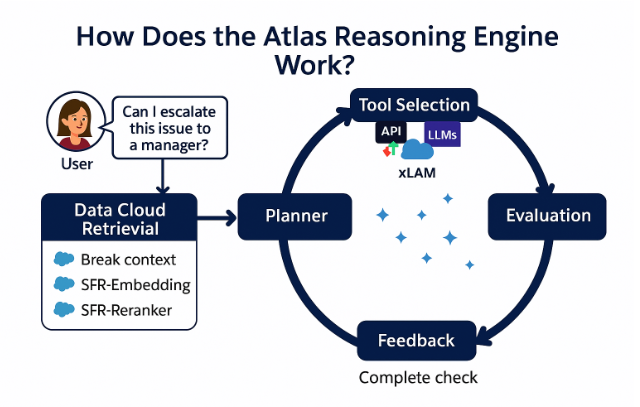Introduction
The AI agent revolution is here, and Salesforce is taking a bold step forward with its Atlas Reasoning Engine, the brain behind Agentforce. In an era where simple question-answering bots fall short, Atlas introduces deliberate, analytical "System 2" thinking to enterprise automation. This isn’t just another AI assistant. It’s a full-blown reasoning engine designed to transform how businesses interact with their data, tools, and processes.
Background & Overview
Announced at TDX and incubated at Salesforce AI Research, the Atlas Reasoning Engine powers Agentforce by orchestrating multi-step, intelligent actions based on user queries. It combines cutting-edge retrieval models, tool selection capabilities, and evaluation mechanisms to handle complex business tasks that go beyond surface-level responses.
Traditional AI excels at "System 1" tasks: fast, pattern-based responses (e.g., 2 + 2 = 4). But when faced with multi-step reasoning (e.g., assessing employee compliance with regional labor laws), it falters. Atlas, however, embodies "System 2" AI thinking — deliberate, context-aware, and adaptive. It retrieves relevant enterprise data, constructs plans, selects the best tools or APIs (including LLMs), and evaluates outputs with a feedback loop.
How the Atlas Reasoning Engine Works Let’s walk through the workflow:

1. User Query and Contextualization
A user asks: "Can a new employee in Germany be assigned to a night shift next week?"
The query is passed into the Data Cloud Retrieval module to understand context: employee profile, organizational HR policies, regional labor laws, and onboarding status.
Initial Retrieval pulls broadly related records.
SFR Embedding, Salesforce's state-of-the-art model, transforms text and queries into embedding vectors to match semantically related documents.
SFR Reranker then filters and prioritizes the most relevant data chunks to reduce noise and improve focus.
2. Planning
With the relevant context in hand, the Planner breaks down the query into manageable, logical sub-steps:
- What are German labor laws on night shifts for new employees?
- What’s the company's internal policy?
- Has the employee completed mandatory onboarding or training?
3. Tool Selection
Here lies the true genius of Atlas.
- Atlas determines which tools to invoke: APIs, databases, or large language models (LLMs).
- xLAM (Large Action Models) come into play here — a Salesforce innovation designed to output executable text, not just responses.
- These models select the appropriate tool, construct the function call with the right parameters, and execute the action.
This system is modular. One query could invoke multiple APIs or LLMs, dynamically tailored to the specific task.






